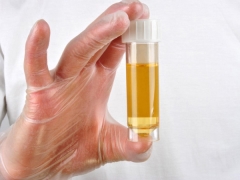Protein in the urine of a child
Your child was prescribed a routine urinalysis, and suddenly the protein index was elevated? Or did the baby show signs of illness, and is there more protein than normal in urine analysis? Let's understand why protein can get into the urine of children and what to do in such situations to parents.
What does he mean?
Normally working kidneys do not allow the loss with urine of necessary substances, including proteins. That is why in the urine of the baby proteins are practically not detected, or their concentration is extremely low. If the work of the kidneys is impaired, a lot of protein penetrates through the filter tubules or it is poorly absorbed back into the blood. However, physiological causes may also lead to the ingestion of a larger amount of protein in the urine, therefore the result of the analysis should be evaluated by the doctor in combination with examination and other studies. Detection of proteins in the urine is called proteinuria.
In newborns and infants
In the first weeks of life, the presence of protein in the urine of an infant is considered a normal variant. This type of proteinuria does not require treatment. Also, the protein may appear in the urine of infants, as a result of overfeeding the baby or an increased intake of nourishing mother's food rich in proteins.
Normal protein should not be?
The normal content of proteins in the urine is up to 0.036 grams per liter. If the concentration of protein in your child's urine analysis is higher, you should look for the causes of this condition. The protein concentration of 1 gram per liter is called moderate proteinuria, and at a rate of 3 grams per liter, they speak of marked proteinuria. First, the doctor will send the baby for re-analysis, after which he will prescribe an additional examination (complete blood count, ultrasound, other studies).
Opinion E. Komarovsky
A famous pediatrician says that urine protein A healthy child should not be detected, and even if it enters the urine, it can be detected only by special techniques that are not used in medical practice.
Komarovsky notes that the presence of protein is first checked by qualitative assay to find out if it is in the urine. Such a test involves mixing the urine with the reagent and observing the reaction - if it occurs, it is a sign of the presence of protein. If there was no reaction, conclusions about the absence of protein are made and the study of this parameter is not carried out further.
In the case when the qualitative sample confirmed the presence of protein in the urine of the baby, then its concentration is determined. According to Komarovsky, quantitative samples can determine protein at concentrations above 0.03 grams per liter. If the indicator is less, you will see the mark “traces of protein” in the analysis.
Additional symptoms for anxiety
An increased indicator of protein content in the urine should be alerted if, in addition to a poor analysis, the child notes:
- Dizziness, drowsiness, fatigue;
- Poor appetite, nausea, vomiting;
- Bone pains;
- Chills, fever;
- Change in urine coloration;
- The presence of edema (the baby may have swelling on the eyelids, remain traces of elastics on the legs).
Possible reasons
Protein can enter the urine of a child after exercise, hypothermia, excessive consumption of protein products, dehydration, fever, or emotional distress. All of these causes cause functional proteinuria.
Abnormal increases in urine protein can be caused by:
- Pyelonephritis;
- Tuberculosis or kidney amyloidosis;
- Glomerulonephritis;
- Burns;
- Poisoning;
- Diabetes mellitus;
- Kidney injury;
- Infectious diseases;
- Tumor processes;
- Hypertension;
- Epilepsy;
- Autoimmune pathologies;
- Blood diseases;
- Allergies;
- Long-term use of drugs.
Why is it better to retake the analysis?
Repeated analysis of urine in order to clarify the presence of proteinuria helps to eliminate errors of the first analysis, as well as a situation where the urine for the study was collected incorrectly. The cause of the increased indicator may be non-sterile capacity or poor washing of the baby, so the doctor, noticing the excess protein in the analysis, immediately offers a retake.
Treatment
Features of the treatment of the baby in the detection of proteinuria will be determined by the cause of the appearance of proteins in the urine. For example, if such a result is caused diabetes mellitus, the child is prescribed treatment for this disease. If the protein is affected by an infection, the baby is given antibiotics. It is often recommended diet with salt restriction, and if the child is infant, then adjust the food of the mother.
In any case, the child should first be examined by a doctor, and any treatment should be performed only after the diagnosis has been clarified. On the use of such folk remedies as cranberry juice, decoctions of parsley root or birch buds, infusion of fir bark, you should also first consult with your doctor.









